- Places
- Plans
- Itineraries
- Experiences
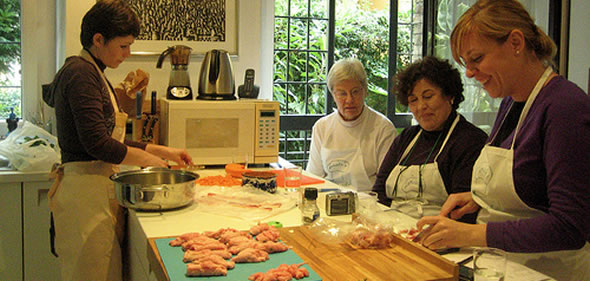
Remember: Vacation calories don't count. Si mangia!
Rather than just taking home from your next trip tales of that fantastic tagliatelle alla bolognese, why not return with the skills to recreate all those great Italian meals in your own kitchen? Cooking schools and cooking lessons are a phenomenal way to while an afternoon—or even for a full week. You get the kind of genuine cultural insight no number of museums and monuments could ever give, you can engage locals on a subject about which they are truly passionate, and you will gain a new skill (or at least new recipes to add to your repertoire). And, of course, you get to eat all your mistakes (mmmm...mistakes)... » more
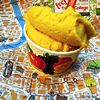
To call gelato "ice cream" is insulting to gelato and unfair to ice cream. Gelato is much richer, smoother, and more flavorful than ice cream. It is churned, not whipped (as is most traditional American ice cream), so it is far denser, giving it a richer mouth feel. Gelato also is not as laden with sugar and cream, so the subtle tastes of its flavoring comes through much better than they do in ice cream... » more

Cicchetti are Venetian tapas—finger foods such as calamari rings, fried olives, potato croquettes, grilled polenta squares, stuffed tomatoes, grilled vegetables, pâtés on rounds of bread, and pretty much anything that can be speared on a toothpick—traditionally washed down with an ombra (shadow), the Venetian nickname for a small glass of wine. Venice has countless cafes and neighborhood bars called bacari where you can order a selection of cicchetti, a panino (sandwich on a roll), or a toast (grilled ham-and-cheese sandwich). All of the above will cost about €1–€2 if you stand at the bar, or as much as double that if you sit at a table... » more
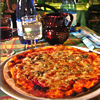
Naples holds a hallowed place in culinary history as the inventors of mankind's most perfect dish: pizza. OK, so that fact might be disputed, but Naples certainly did perfect the pizza—and one pizzeria in town can lay claim to having come up with the simple tomato sauce-cheese-basil topping that we now call a "plain pizza"—and they did it to honor the visiting Queen of Italy in 1889... » more

An agriturismo is a working farm in Italy that also offers inexpensive (and often quite lovely) B&B-style accommodation. Many agriturismi also have restaurants featuring wonderfully huge, cheap, and hearty home-cooked dinners,—usually four or five hearty courses of food fresh from the fields and pastures just outside your window and often ringing it at a mind-blowingly inexpensive €30 to €45 per person for everything, including wine (table wine, of course, but one produced on-site, at a neighbor's, or at least by a member of the extended family)... » more
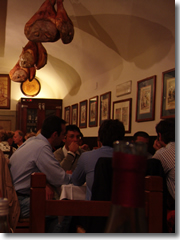
If I had to single out one spot for that archetypal Italian feast, the one that lasts for hours and has more courses than you can count, it would be Il Latini. Sure, there are thousands of places in Italy where you can indulge in the marathon four-hour dinner, but Il Il Latini is in the heart of Florence, and it is the old standby for that classic Tuscan full meal. Yes, there are loads of tourists inside, but there are loads of Florentines as well, everyone puzzled together at long communal tables under pendulums of prosciutto hamhocks hanging from the wood rafters. They have all come for the Latini feast—appetizers of crostini, hearty plates of pasta or bowls of ribollita soup, heaping platters of grilled meats, veggies, biscotti, and all the wine, water, and grappa you can drink—all for one set price that's a bit of a splurge but won't break the bank... » more
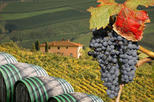
There are hundreds of wine regions in Italy, dozens of which are world-famous, but if you can pick only one, it has to the be Chianti Classico.
The 30-mile stretch of the Chianti hills between Florence and Siena comprises one of the planet's most famous wine-producing regions.
The steep slopes are cloaked in terraced rows of vines and peppered with medieval castles and cypress-shrouded abbeys.
The narrow valleys are laced with tiny rivers along which are sprinkled small market towns: Greve in Chianti (the unofficial capital of the Chianti), Radda in Chianti, Gaiole in Chianti.
This idyllic landscape is also peppered with wineries, many of which open their doors to the public and invite you in to sample the goods.
... » more
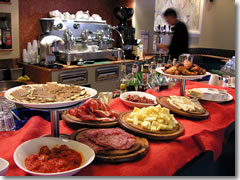
Aperitivi ("aperitifs") is a simple idea: basically, it's Happy Hour with free nosh. During the daily see-and-be-seen passeggiata strolling hour between the end of the workday and the start of dinner (5pm to 7pm or so), many bars and cafes in cities from Rome to Milan to Torino will lay out free stuzzichini (little snacks) to draw in patrons. In some cases, the fare is just basic bar snacks, but an increasing number of downtown cafes—especially trendy ones—load down the bar or long tables groaning under the weight of dozens upon dozens of mouth-watering canapés, tapas, and tidbits—all for free... » more

Life in Bologna centers around the kitchen. These people just love to eat—and eat well. To get under the skin of this city, take a morning to explore the gastronomic side of Bologna: its street markets, wine bars, fourth-generation grocers, traditional pasta makers, and storied chocolatiers. in the city that invented ragú, or bolognese, sauce, those studfed-pasta gems called tortellini, and a cured meat product named mortadella so wildly popular the world over (particularly in school lunches) that most cultures call it simply "bologna"—or, if you prefer, baloney... » more
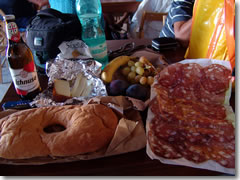
A bottle of Chianti, a crusty loaf of bread, some fresh fruit, creamy local cheeses and spicy salamis, salty prosciutto, tangy olives, and a flaky pastry to top it all off makes a fabulous meal. Stop at a half dozen little neighborhood shops, and maybe stop by the local market, and for less than $10 per person you can put together a feast worthy of a Roman emperor or Renaissance prine... » more
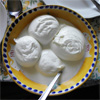
The plains of the Cliento coast, just south of the Amalfi Coast in Italy's Campania region, are most famous among travelers for the amazing ruins of 6th and 5th century BC Greek temples sprouting among the scrub and poppies at Paestum. However, these coastal lowlands are also the epicenter of Italy's mozzarella production. A stroll from the ruins to the beach, you'll pass numerous signs advertising "vendita diretta"—direct sales— at mozzarella farms wher eyou can wander past lines of lowing European water buffalo to sample mozzarella fresh from the source...
... » more
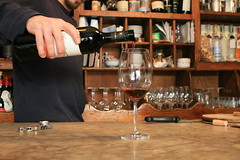
Italy, with the right kind of terrain and the perfect amounts of sun and rainfall, happens to be ideal for growing grapes. Centuries ago, the Etruscans had a hearty wine industry, and the ancient Greeks bolstered it by transplanting their vine cuttings to Italy’s southlands. And it was Italy, under the Romans, that first introduced the vine and its possibilities to France and Germany.
Today, Italy exports more wine to the rest of the world than any other country. But there’s plenty left at home from which to choose—more than 2,000 wines are produced in Italy, and you can sample many by the glass at Italian wine bars... » more
While for some activities you can just show up, this is one travel item you really should try to reserve in advance.
Popular activities like cooking classes can sell out.
Many are available only on certain days of the week, so it pays to know that you'll have to set aside, say, Tuesday morning for that guided market walk with a local cookbook author.
Many of the best activities are available by advance booking or appointment only—particularly wineries. Some vineyards welcome walk-ins, true, but many more will give you a cellar tour and wine tasting only if you call ahead a few days (and those tend to be the ones most liberal with the free samples).
If you have your heart set on dining in a particular restaurant, go ahead and call ahead,even if it's just earlier on the same day—though a day ahead is preferable. I have found that a corrollary of Muphy's Law applies to this aspect of travel. Any restaurant I am particularly keen on but blithely assume I can just waltz into will inevitably be filled to the brim: no tables available. However, half the time when I do book a table in advance I'll end up being the only guy in the place (nor near enough for my advance booking to feel like overkill). Still, better safe than sorry. Reserving a table is quick and painless; getting turned away at the door can be crushing.
Share this page
Search ReidsItaly.com